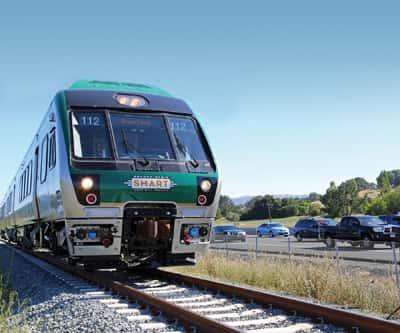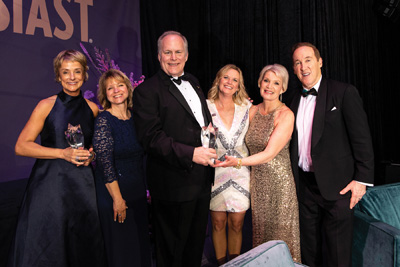The Bay Area is an economic powerhouse, a unique region of the country interwoven with remarkable amenities. But even though it’s critically important to the California economy, it has yet to reach its full potential due to a congested and inadequate transportation infrastructure. Long commutes, along with the accompanying gridlock, are producing a slow-but-steady deterioration of our quality of life.
This isn’t to say our North Bay cities don’t offer ample opportunities for intelligent development. They’ve learned from mistakes made by planners to the south, and have put critical developmental safeguards in place quite some time ago. However, they’re plagued by the limitations of their transportation infrastructure. A single roadway, Highway 101, links them all to San Francisco. Congestion, accidents and pollution are an inescapable result of this single transportation alternative. But efforts to improve the situation have taken many years (consider the Novato Narrows and Doyle Drive projects). And while everyone waits, the problems only fester, stunting the growth of the entire region as resources are diverted to even more intractable problems on East and South Bay roadways.
The Sonoma Marin Area Rail Transit (SMART) initiative was an attempt to find another way to address these issues. As a concept, SMART had much to offer. It employed a publicly owned right-of-way to circumnavigate the limitations of Highway 101; it provided long-dormant economic capacity to resume freight shipments to the north; and it provided a modest level of passenger service between North Bay cities. It all came at a cost, however.
In addition to the considerable financial cost ($70 per passenger in perpetuity after a $387 million initial outlay), the project offered only low frequency of passenger service, and a modest reduction of Highway 101 traffic. It transits through some environmentally sensitive areas, and it will contribute its share of pollution and greenhouse gases to a region already strongly committed to their reduction.
For these and other reasons, voters rejected the SMART proposal three times in the past seven years. But planning continues, and the SMART proposal will return to the ballot in 2008.
My colleagues and I endorse the promise of the SMART concept, and our experience has convinced us that it could be successful if offered through a different technology platform, specifically magnetic levitation (maglev). Maglev is a proven transportation technology already being used in both China and Japan with additional test tracks in Germany and Korea.
Our firm, LLC, has spent the last few years evaluating the potential of this technology in eight prospective locations in the United States. We’ve had good technical assessment results (see, for example, the Colorado Maglev Project). These efforts have convinced us that maglev technology could rehabilitate the SMART concept, removing the negative elements that have so far blocked it.
The first benefit of maglev is performance. We propose that three-car trains should run every four minutes during the peak hours, making the trip from Santa Rosa to the Larkspur ferry terminal at 125 miles per hour; the trip would take about 20 minutes at this speed. This system could carry 15,000 passengers daily during peak travel times.
The potential benefits of removing 15,000 commuting cars from the freeway include annual reduced emissions amounting to roughly 655 million pounds of CO2, accompanied by equally impressive amounts of CO, NOX and volatile organics. Additionally, roughly $100 million in annual commuter cost would stay in the local economy instead of going directly to petroleum interests.
Further, maglev has the benefit of all-electric operation (hydro or geothermal), freedom from noise pollution and minimal impact on wildlife and sensitive areas due to very limited land use requirements. Operations and maintenance costs are low: the system is automated, and the non-contact nature of the track means the system lifetime is approximately 75 years. No other system of transportation technology can provide all these benefits.
All this comes at a cost, however. But although perceptions of staggering cost have prevented maglev from reaching any meaningful level of awareness in the general U.S. population, our evaluations have shown the perceptions of high cost to be incorrect, relatively speaking. Presently, transportation projects in many parts of the country are severely overrun, frequently by factors of two.
When people think of maglev, they commonly associate it with heavy rail systems that include both subway systems and commuter rails, which are both inordinately costly. However, maglev in its present form bears no relationship to these rail technologies. Maglev employs lightweight guideways that require little or no maintenance and, as primarily an elevated technology, merely requires the installation of relatively small supporting columns along the right-of-way. Elevation eliminates dangerous road crossings and accidental wildlife kills, while enhancing passenger safety and security.
In 2003, cost estimates for maglev guideway construction were in the range of $18 million per mile. While guideway construction typically makes up 60 percent of the final system cost, the 37-mile Marin-Sonoma corridor appears to have relatively few construction challenges. If further study bore this out, the system cost for the entire Marin-Sonoma corridor could probably be kept below $800 million, even with a generous contingency. This cost compares extremely favorably with the cost of previously proposed light and heavy rail systems.
Because of the economic and environmental benefits offered by maglev, we believe it could be configured to operate without subsidy and could represent an opportunity for a unique public-private partnership funding approach.
Every maglev development has unique challenges, and the only way to properly envision maglev in the Marin-Sonoma corridor is to perform a full and unbiased evaluation of its potential deployment. A positive result leading to enthusiastic endorsement by the voters could easily follow, opening new economic doors for the region and the state.



